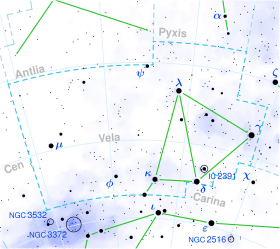| Observation data Epoch J2000 Equinox J2000 | |
|---|---|
| Constellation | Vela |
| Right ascension | 10h 37m 18.13995s [1] |
| Declination | −48° 13′ 32.2349″ [1] |
| Apparent magnitude (V) | 3.83 [2] (4.13 / 5.76) [3] |
| Characteristics | |
| Spectral type | F3IV + F0V + A6V [2] |
| U−B color index | +0.04 [2] |
| B−V color index | +0.31 [2] |
| Astrometry | |
| Radial velocity (Rv) | 21.20 ± 0.7 [4] km/s |
| Proper motion (μ) | RA: -133.41 [1] mas/yr Dec.: -1.82 [1] mas/yr |
| Parallax (π) | 37.26±0.36 mas [1] |
| Distance | 87.5 ± 0.8 ly (26.8 ± 0.3 pc) |
| Absolute magnitude (MV) | 2.15 / 2.70 / 2.14 [2] |
| Orbit [3] | |
| Primary | p Vel A |
| Companion | p Vel B |
| Period (P) | 16.651 yr |
| Semi-major axis (a) | 0.361″ |
| Eccentricity (e) | 0.726 |
| Inclination (i) | 128.5° |
| Longitude of the node (Ω) | 37.2° |
| Periastron epoch (T) | 2019.562 |
| Argument of periastron (ω) (secondary) | 288.9° |
| Details [5] | |
| p Vel Aa | |
| Mass | 1.88 M☉ |
| Radius | 2.56 [a] R☉ |
| Luminosity | 12.5 L☉ |
| Temperature | 6,710 K |
| p Vel Ab | |
| Mass | 1.29 M☉ |
| Radius | 1.22 [a] R☉ |
| Luminosity | 2.79 L☉ |
| Temperature | 6,740 K |
| p Vel B | |
| Mass | 2.41 [2] M☉ |
| Other designations | |
| CD−47°6042, HIP 51986, HR 4167, SAO 222199 | |
| p Vel A: HD 92139 | |
| p Vel B: HD 92140 | |
| Database references | |
| SIMBAD | data |
p Velorum (abbreviated to p Vel) is a triple star system in the constellation Vela. Parallax measurements by the Hipparcos spacecraft put it at a distance of 87.5 light-years, or 26.8 parsecs from Earth. [1] It is visible to the naked eye with a combined apparent magnitude of 3.83. [2]
The primary component is a spectroscopic binary whose components have an orbital period of 10.21 days. The inner spectroscopic binary consists of two F-type stars, a subgiant and a main-sequence star. [2] There is a companion star which is a white A-type main-sequence star, with an apparent magnitude of 5.76. [3] It is separated 0.361 arcseconds from the primary and has an orbital period of 16.651 years. [3]


